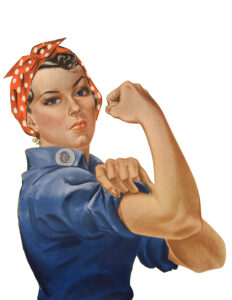CTE Shop Class: Now It’s High-Tech
Career Ed – Respectable Again?

Rosie the Riveter is a popular image from WWII representing the women who worked in the factories. (Credit: Public Domain Pictures)
Each March, we honor the accomplishments of strong, determined women with “National Women’s History Month. Established by presidential order to honor the contributions of Women in our society, its roots go back to female textile workers protesting their poor working conditions and unequal rights in New York City on March 8, 1857. It was one of the first organized strikes by working women.
Half a century later, in March 1908 more women needle trades workers marched through the City’s Lower East Side to again protest the unfair treatment of subsequent generations of working women. On March 8th that year, their activism led to the first “International Women’s Day,” and later to the establishment of Women’s History Week, which became Women’s History Month in 1987.
What began as protests highlighting the importance of women skilled trade workers, became critically important during World War II, when most working men were compelled, by honor or the draft, to leave their industrial jobs to fight in our military. This created a severe shortage of skilled workers in all areas of manufacturing. Throughout the war effort, women repeatedly stepped up to contribute by taking “men’s” factory jobs in every industry.
The famous images of “Rosie the Riveter,” epitomized the contributions of all the women who helped win WW2, by producing the weapons and other materials their men used to defeat our enemies.
Women welders built the aircraft carriers that delivered the planes real-life riveting Rosies constructed. Millions of other women produced the clothing, food, fuel, and other essential supplies of war. Their efforts were essential to our victory in WW2.
The legacies of those female skilled trade workers demonstrated that women could perform with skills equal to men – in “men’s jobs.”
What does this have to do with education? The women of “The Greatest Generation,” proved that with proper training, their natural aptitude for trade work allowed them to perform, even out-perform, in skilled trade jobs.
After the war, things returned to “normal,” with men displacing women in industrial jobs.
As in WW2, today our economy again faces a severe shortage of skilled tradesmen. Knowing that women proved they can perform in those roles during wartime, we again need them to fill gaps in our industrial workforce. During the war, women received rapid training in every aspect of trade skills, making them fully capable of performing in those roles. Unfortunately, since WW2 schools have dismantled most of our trade education programs, so that we do not currently even graduate enough men for our skilled trades.
The solution to our workforce problem lies in encouraging young woman to obtain trade skills as their great grandmothers once did and providing CTE training for all who want it.
Sometimes, the best skilled tradesman – IS A WOMAN!




